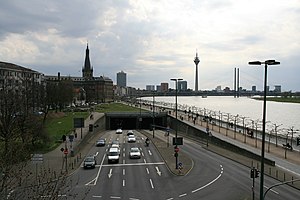Rheinufertunnel (Düsseldorf)
|
|
||
|---|---|---|
|
North side of the Rhine bank tunnel
|
||
| use | Road tunnel | |
| traffic connection | B1 | |
| place | Dusseldorf | |
| length | 1928 m | |
| vehicles per day | 55000 | |
| Number of tubes | 2 | |
| cross-section | Rectangular profile | |
| construction | ||
| start of building | March 15, 1990 | |
| completion | 1993 | |
| business | ||
| release | December 15, 1993 | |
| location | ||
|
|
||
| Coordinates | ||
| North entrance | 51 ° 13 ′ 49 ″ N , 6 ° 46 ′ 17 ″ E | |
| South entrance | 51 ° 12 ′ 37 " N , 6 ° 45 ′ 31" E | |
The Düsseldorf Rheinufertunnel is an almost two kilometer long four-lane road tunnel in Düsseldorf and part of the federal highway 1 .
It runs on the right bank of the Rhine and was opened to traffic on December 15, 1993 after three and a half years of construction. It is considered Düsseldorf's project of the century and one of the largest traffic calming projects to date, as Düsseldorf was too separated from the Rhine by the busy Rheinuferstraße. There are now 55,000 cars underground every day. A branched pipe system ensures the connection of many other, often four-lane roads, such as the Rheinkniebrücke . Because of the narrow space, 2 × 2 directional lanes run over each other for about half. On a floor in between there is the exhibition Art in the Tunnel as well as in front of and behind further tubes in which the arms of the river Düssel are led to the Rhine. The southern entrance to the Rheinufertunnel is impressively designed in the form of a high-rise gate , the Düsseldorf city gate . The northern entrance is just south of the Oberkasseler Bridge .
The Rheinufertunnel has the following entrances and exits:
- Düsseldorf-Bilk (south front entrance, city gate)
- Düsseldorf-Unterbilk
- WDR / port
- State Parliament / Rhine Tower
- Knee bridge
- Center / Oberkassel
- Joseph-Beuys-Ufer (front entrance north).
The pioneering plan for the planning and construction of the Rhine bank tunnel was the Council decision of 1976, which commissioned an expert study for this area. Result: Large parts of the port are no longer required for traditional port handling. This cleared the way for planning to lower Rheinuferstraße. The annoying part of federal highway 1, which was run as an elevated road, should also disappear. On December 17, 1987, the city council finally took the decision in principle to build and on March 15, 1990 the first groundbreaking took place.
Around 235,000 cubic meters of concrete and 22,000 tons of reinforcing steel were used for the tunnel. Around 125,000 truckloads of earth were removed. The tunnel's equipment includes 72 fans, 1657 lights and emergency lights. There are also 53 surveillance cameras installed. 120 kilometers of cables were laid. Cell phone use and radio reception are possible. The construction costs amounted to half a billion euros; the annual operating costs are 500,000 euros.
With the construction of the tunnel, the Rhine promenade from 1900 was largely restored. It describes a total of around three kilometers of walkway north and south of the Rhine Tower along the banks of Düsseldorf's right bank. Since the traffic flow is now underground, the most famous district of Düsseldorf, the old town , borders on the banks of the Rhine again. The above-ground part of the street has been considerably calmed down and is now one of the city's attractions for pedestrians, skaters and cyclists, where many open-air events take place. Due to the further development of the Rhine promenade, the skyline seen from the Rhine now appears very imposing.
As a result, sophisticated architecture also settled on the banks of the Rhine. At the southern end of the tunnel, the city has been completely redesigned over the past 25 years. This is how the Rheinturm , the building of the NRW state parliament , the Düsseldorf city gate and the media harbor with the office towers designed by the architect Frank Gehry were built .
Since October 2009, eight so-called “ black flash ” cameras with invisible flash have been monitoring the speed at the beginning and end of the tunnel on both lanes in each direction. For violations when driving in and out, the offense applies , so that only the more serious violation is punished. At the same time, the maximum speed allowed was increased from 60 to 70 km / h. This was reduced again to 60 km / h on September 11, 2019.
Right at the beginning of the commissioning of the system there was an error in the determined crime time. According to the authorities, it took just under five minutes to drive south for the 2 kilometers - despite the speed limit being exceeded. The Rheinufertunnel has its own parking garage entrance to the "Altstadt Rheinufer" parking garage, which is located directly under the two tunnel tubes.
See also
Web links
- Photo series for the construction of the Rhine bank tunnel
- City of Düsseldorf - banks of the Rhine (1)
- City of Düsseldorf - banks of the Rhine (2)


